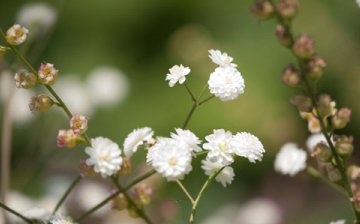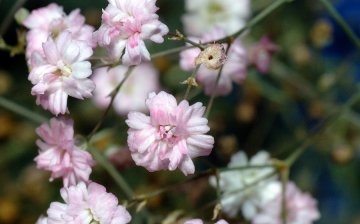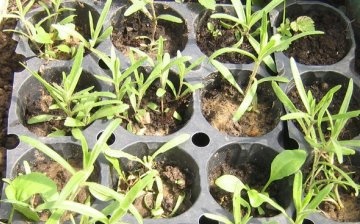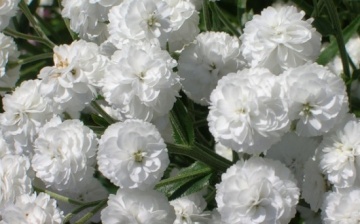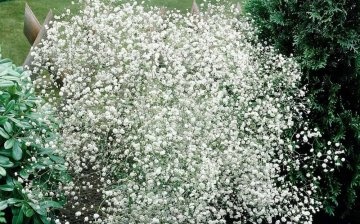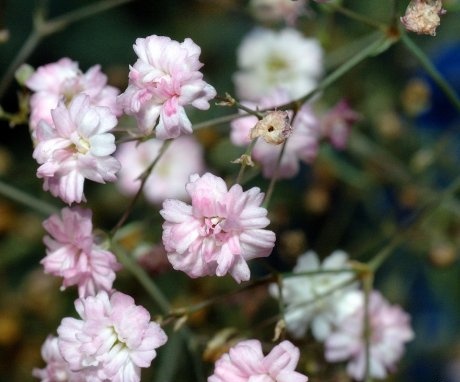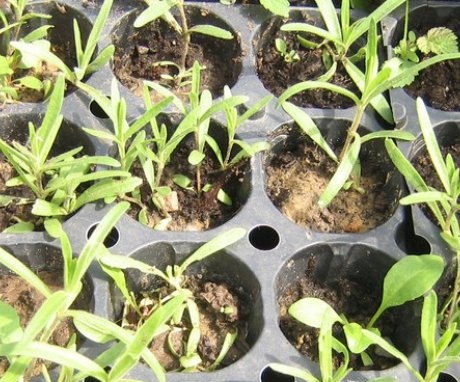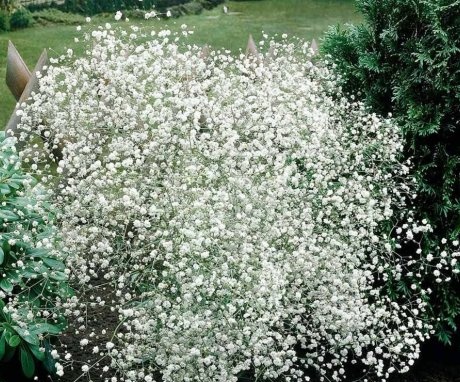Gypsophila paniculata: breeding methods and growing rules
Gypsophila - a plant that is valued for its delicate, albeit small flowers and beautiful crown shape. One of the most famous and popular species is gypsophila paniculata.
Content
- Gypsophila paniculata: description and popular varieties
- Reproduction of gypsophila paniculata
- Growing rules
- Using gypsophila
Gypsophila paniculata: description and popular varieties
Gypsophila, she is a gypsum lover, kachim is a herbaceous plant of the clove family. In total, it has more than a hundred species. Among them there are annuals and perennials. Grows wild in the steppes of Eurasia, Africa, Australia. The name suggests that the plant loves gypsum, that is, it grows well on limestone soils. One of the names is "tumbleweed". For the delicacy and tenderness of the crown, it is called "the breath of a child."
Gypsophila paniculata is the most common type.
It differs from others in the large size of the plant and flower. From a distance, the bush resembles an openwork light ball. The stem height ranges from 0.35 m to 1.2 m, depending on the variety. There are almost no leaves on it. Branched stems underneath are decorated with narrow gray-green leaves. They are small, shaggy underneath. From above, the branched stems are covered with a huge number of flowers, simple or double. The size of each reaches 8 mm. The flowers are white and pink in varying intensities. They are collected in panicle inflorescences. The color of the bud may change after the flower opens.
The fruit is a polyspermous capsule with a huge number of small seed... There are more than a thousand of them in one gram. They remain viable for two to three years. The gypsophila root reaches 70 cm. This helps it to get water even in dry times. But replanting a plant with such a long root is difficult. Therefore, it must be planted immediately in the right place. The width of the bush is 1 m.
The most interesting varieties of gypsophila paniculata:
- Terry - with small white double flowers.
- Blistol Firey - flowers are also double, but large.
- Flamingo is a tall bush covered with pink double flowers.
- Rosenschleyer - blooms up to 3 months with small flowers of pale pink color.
- Pink Star is a plant with dark pink flowers.
- Rosie Vale is a short variety with flowers that change color.
Reproduction of gypsophila paniculata
Growing gypsophila seedlings:
- Seeds for seedlings are sown in March. The soil is prepared by adding to the purchased garden soil, sand, chalk. Do not seal.
- Seeds are sown on wet soil at a distance of up to 10 cm from each other. In this case, the seedlings will not be thickened, and they will not be needed. dive... You can lightly sprinkle with the remaining soil.
- The dishes are covered with glass or foil. Germination takes place at room temperature. After a couple of days, the seeds germinate, but real leaves appear in them after two or even three weeks. All this time, dishes with plants should be in a sunny place.
- Watering must be done carefully so as not to overmoisten the plants.
- They are sown on a permanent place in May. It will bloom in the second or third year.
You can grow gypsophila from seeds outdoors.Especially if you are not limited in the amount of seed. The soil is prepared in the same way as when growing indoors. Sow seeds. Sprinkle them with soil a little. Seedlings will appear in 10 days. A month after sowing them dive... They are planted in a permanent place in the fall. The distance between plants should be at least a meter.
Propagate gypsophila cuttings, especially varieties with double flowers.
Indeed, when propagated by seeds, this property is not preserved. Before flowering, cut off the upper part of the stem about 8 cm long. Prepare the soil as when sowing.
Moisten the soil, set cuttings in it. The dishes are placed in a warm place without direct sunlight. You can cover the top with foil or cans, but they must be removed periodically in order to ensure the flow of fresh air to the cuttings. Rooting occurs a couple of months after placing the cuttings in the soil. Towards autumn, young plants are transplanted into the garden.
Growing rules
Gypsophila grows well on light sandy soils and loams of slightly alkaline or neutral soils (pH 6.3). Loves porous soil, which allows air to pass through well and does not allow moisture to accumulate in the upper layers. Can be planted in areas with rocky soil.
Before planting the gypsophila paniculata in ordinary soil, sand and small pebbles are added to it.
If the soil is acidic, add lime or chalk. Grows best in sunny areas. Transfers light shading for several hours. Cannot be planted in areas with a close occurrence of groundwater. Their level should not reach the root.
Gypsophila paniculata is not very demanding in introduction fertilizers... You can feed her in two weeks. It is permissible to introduce humus and mineral fertilizers... It is only necessary to ensure that the acidity of the soil does not increase after that.
Watering rules:
- Watering young plants in the heat is necessary daily, under normal conditions - in a couple of days.
- Watered at the root.
- Adult plants are watered only after the soil underneath is dry.
Diseases and pests:
- In rainy weather, gypsophila paniculata can be affected by fungal diseases... This is gray rot, jaundice, rust. When the first signs of the disease are detected (gray or white spots, weeping areas on the stem), they are treated with foundation or means containing copper. Re sprayed plants in a month. If necessary, repeat the treatment again.
- Gypsophila paniculata can be affected by caterpillars, thrips, nematode, gall and cyst-forming. Growths on the stems indicate their appearance. You can fight pests with thiazone.
In the fall, after the gypsophila paniculata has faded, the dried stems are cut to a height of 7 cm from the ground. This should be done in October. In winter, gypsophila paniculata does not need special conservation measures. You can throw fallen leaves, spruce branches on it. Keeps well under a layer of snow. If, in severe frosts and snowless weather, Gypsophila paniculata freezes, then young plants often grow from seeds instead.
Using gypsophila
Looks great:
- In the flower beds.
- In any group plantings.
- Near plants with large single flowers.
- Planted separately.
- Cut in bouquets.
The stems under the weight of the leaves gypsophila often lean to one side, disrupting the beauty of the crown. To prevent this from happening, the plant is supported with special supports. They can be made in the form of a slingshot if only some of the stems are collapsed. If many branches fall, you can arrange for them to be supported in the form of the letter P. The stems will develop, and in the future they will hide the support.
Gypsophila paniculata refers to plants that do not require special care.
It is only necessary to create the necessary conditions for it before planting it in a permanent place, and then you can admire its beauty for many years. Subject to the rules for caring for the gypsophila plant, paniculata can grow in one place for up to 25 years.
More information can be found in the video.



